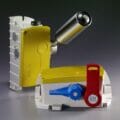According to research by SKF USA Inc, improper bearing lubrication accounts for up to 50 per cent of machine failures. This comes as machine and equipment manufacturers feel pressure to reduce costs without sacrificing machine performance — a difficult balancing act. Here, Chris Johnson, managing director at specialist bearing supplier SMB Bearings, explains the different types of lubrication cost and how to avoid them.
The cost of lubrication doesn’t only include initial purchasing and installation. Factors during the lubricant’s whole lifespan can contribute towards overall expense. They include training of staff, ongoing maintenance and — as shown in SKF USA’s report — machine failures caused by improper lubrication.
Let’s look at the most common costs associated with lubricants, and how businesses can predict and reduce them.
Hidden costs
Contaminated lubricants can cause premature wear and tear on bearings as the lubrication becomes less effective over time and leads to more downtime due to maintenance and replacement. If businesses don’t proactively manage lubricants by making machine adjustments, monitoring parts and cleaning them, they will not be able to assess when re-lubrication, and therefore planned downtime, is needed.
The time taken to carry out regular assessments of lubrication quality also adds to overall costs of lubricant expenditure. Labour costs associated with checking systems can be overlooked by manufacturers and can escalate further if systems are not running efficiently or if problems remain unchecked and escalate.
There are costs associated with introducing lubricants to a system, but also with disposing of them. According to Valin, proper disposal of lubricants by an external process management company can account for approximately 20 per cent of a business’s annual spend on lubricants. Safe and effective lubricant removal must be expertly planned to avoid unexpected costs.
Training
Training employees on how to avoid lubricant contamination allows businesses to maintain lubricant efficiency for longer and reduce the wear on parts. Employees need to know which signs to look out for to proactively re-lubricate bearings, forward plan maintenance, and reduce unplanned downtime. Businesses can contact a bearings lubrication expert, like SMB Bearings, for guidance and help with educating their workforce.
Expert support
If businesses don’t have the expertise in-house, they can invest in support with removing and integrating lubricants. Contacting an external provider gives businesses the peace of mind that the work is being carried out to the highest standards and will last the longest amount of time.
External specialists can also spot any issues that may be costly in the future, such as damaged bearings from inadequate lubrication. They can work with the business to reduce damage in the short-term and create a longer-term maintenance plan to solve the issue. This process allows them to prepare for future costs, and proactively reduce any damage that may already be occurring.
The lubrication must suit the application whether it be high speeds, temperature extremes, chemical exposure or contact with other liquids. Failure to ensure that the lubrication fits the application can lead to increased operating and maintenance costs for businesses. That’s why being aware of hidden costs throughout the system’s lifespan, and proactively solving these issues, is key to a company’s bottom line.
For more information about SMB Bearings’ lubrication product range and expertise, visit the website here.








